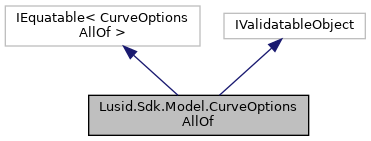CurveOptionsAllOf
More...
|
| MarketDataOptionsTypeEnum | MarketDataOptionsType [get, set] |
| | The available values are: CurveOptions More...
|
| |
| string | DayCountConvention [get, set] |
| | Day count convention of the curve. Defaults to "Act360". More...
|
| |
| string | FrontExtrapolationType [get, set] |
| | What type of extrapolation is used to build the curve Imagine that the curve is facing the observer(you), then the "front" direction is the closest point on the curve onward. <br /> example: 0D tenor to past Defaults to "Flat". Supported string (enumeration) values are: [None, Flat, Linear]. More...
|
| |
| string | BackExtrapolationType [get, set] |
| | What type of extrapolation is used to build the curve. <br /> Imagine that the curve is facing the observer(you), then the "back" direction is the furthest point on the curve onward. <br /> example: 30Y tenor to infinity Defaults to "Flat". Supported string (enumeration) values are: [None, Flat, Linear]. More...
|
| |
◆ MarketDataOptionsTypeEnum
◆ CurveOptionsAllOf() [1/2]
| Lusid.Sdk.Model.CurveOptionsAllOf.CurveOptionsAllOf |
( |
| ) |
|
|
inlineprotected |
◆ CurveOptionsAllOf() [2/2]
| Lusid.Sdk.Model.CurveOptionsAllOf.CurveOptionsAllOf |
( |
string |
dayCountConvention = default(string), |
|
|
string |
frontExtrapolationType = default(string), |
|
|
string |
backExtrapolationType = default(string), |
|
|
MarketDataOptionsTypeEnum |
marketDataOptionsType = default(MarketDataOptionsTypeEnum) |
|
) |
| |
|
inline |
Initializes a new instance of the CurveOptionsAllOf class.
- Parameters
-
| dayCountConvention | Day count convention of the curve. Defaults to "Act360".. |
| frontExtrapolationType | What type of extrapolation is used to build the curve Imagine that the curve is facing the observer(you), then the "front" direction is the closest point on the curve onward. <br /> example: 0D tenor to past Defaults to "Flat". Supported string (enumeration) values are: [None, Flat, Linear].. |
| backExtrapolationType | What type of extrapolation is used to build the curve. <br /> Imagine that the curve is facing the observer(you), then the "back" direction is the furthest point on the curve onward. <br /> example: 30Y tenor to infinity Defaults to "Flat". Supported string (enumeration) values are: [None, Flat, Linear].. |
| marketDataOptionsType | The available values are: CurveOptions (required). |
◆ Equals() [1/2]
◆ Equals() [2/2]
| override bool Lusid.Sdk.Model.CurveOptionsAllOf.Equals |
( |
object |
input | ) |
|
|
inline |
Returns true if objects are equal
- Parameters
-
| input | Object to be compared |
- Returns
- Boolean
◆ GetHashCode()
| override int Lusid.Sdk.Model.CurveOptionsAllOf.GetHashCode |
( |
| ) |
|
|
inline |
Gets the hash code
- Returns
- Hash code
◆ ToJson()
| virtual string Lusid.Sdk.Model.CurveOptionsAllOf.ToJson |
( |
| ) |
|
|
inlinevirtual |
Returns the JSON string presentation of the object
- Returns
- JSON string presentation of the object
◆ ToString()
| override string Lusid.Sdk.Model.CurveOptionsAllOf.ToString |
( |
| ) |
|
|
inline |
Returns the string presentation of the object
- Returns
- String presentation of the object
◆ BackExtrapolationType
| string Lusid.Sdk.Model.CurveOptionsAllOf.BackExtrapolationType |
|
getset |
What type of extrapolation is used to build the curve. <br /> Imagine that the curve is facing the observer(you), then the "back" direction is the furthest point on the curve onward. <br /> example: 30Y tenor to infinity Defaults to "Flat". Supported string (enumeration) values are: [None, Flat, Linear].
What type of extrapolation is used to build the curve. <br /> Imagine that the curve is facing the observer(you), then the "back" direction is the furthest point on the curve onward. <br /> example: 30Y tenor to infinity Defaults to "Flat". Supported string (enumeration) values are: [None, Flat, Linear].
◆ DayCountConvention
| string Lusid.Sdk.Model.CurveOptionsAllOf.DayCountConvention |
|
getset |
Day count convention of the curve. Defaults to "Act360".
Day count convention of the curve. Defaults to "Act360".
◆ FrontExtrapolationType
| string Lusid.Sdk.Model.CurveOptionsAllOf.FrontExtrapolationType |
|
getset |
What type of extrapolation is used to build the curve Imagine that the curve is facing the observer(you), then the "front" direction is the closest point on the curve onward. <br /> example: 0D tenor to past Defaults to "Flat". Supported string (enumeration) values are: [None, Flat, Linear].
What type of extrapolation is used to build the curve Imagine that the curve is facing the observer(you), then the "front" direction is the closest point on the curve onward. <br /> example: 0D tenor to past Defaults to "Flat". Supported string (enumeration) values are: [None, Flat, Linear].
◆ MarketDataOptionsType
The documentation for this class was generated from the following file:
- /home/docs/checkouts/readthedocs.org/user_builds/lusid-sdk-csharp/checkouts/latest/sdk/Lusid.Sdk/Model/CurveOptionsAllOf.cs
